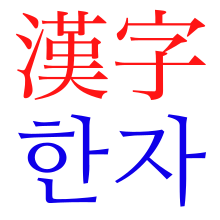Hanmun
| Hanja |
|
|---|---|
| Type | |
| Languages | Korean |
|
Parent systems
|
|
|
Sister systems
|
Kanji, Zhuyin, Traditional Chinese, chữ nôm, Khitan script, Jurchen script |
| Hanja | |
 |
|
| Korean name | |
|---|---|
| Hangul | |
| Hanja | |
| Revised Romanization | Hanja |
| McCune–Reischauer | hancha |
Hanja (Korean pronunciation: [ha(ː)nt͈ɕa]) is the Korean name for Chinese characters (Chinese: 漢字; pinyin: hànzì). More specifically, it refers to those Chinese characters borrowed from Chinese and incorporated into the Korean language with Korean pronunciation. Hanja-mal or hanja-eo refers to words that can be written with hanja, and hanmun (한문, 漢文) refers to Classical Chinese writing, although "hanja" is sometimes used loosely to encompass these other concepts. Because hanja never underwent major reform, they are almost entirely identical to traditional Chinese and kyūjitai characters. Only a small number of hanja characters are modified or unique to Korean. By contrast, many of the Chinese characters currently in use in Japan and Mainland China have been simplified, and contain fewer strokes than the corresponding hanja characters.
Although a phonetic Korean alphabet, now known as hangul, had been created by a team of scholars commissioned in the 1440s by King Sejong the Great, it did not come into widespread use until the late 19th and early 20th century. Thus, until that time it was necessary to be fluent in reading and writing hanja in order to be literate in Korean, as the vast majority of Korean literature and most other Korean documents were written in hanja. Today, a good working knowledge of Chinese characters is still important for anyone who wishes to study older texts (up to about the 1990s), or anyone who wishes to read scholarly texts in the humanities. Learning a certain number of hanja is very helpful for understanding the etymology of Sino-Korean words, and for enlarging one's Korean vocabulary. Hanja are not used to write native Korean words, which are always rendered in hangul, and even words of Chinese origin—hanja-eo (한자어, 漢字語)—are written with the hangul alphabet most of the time.
...
Wikipedia
